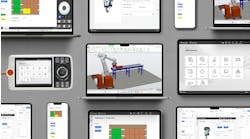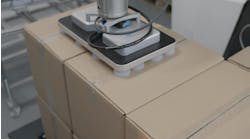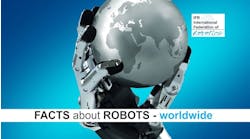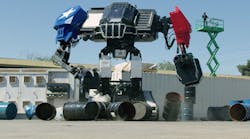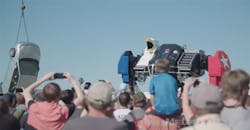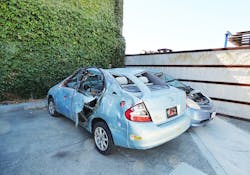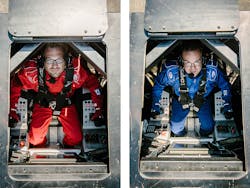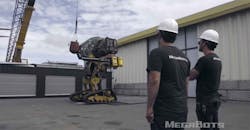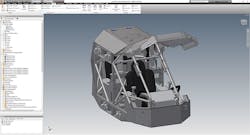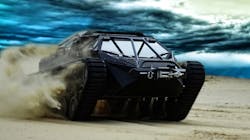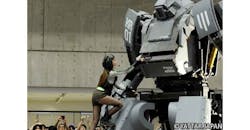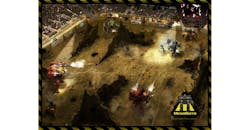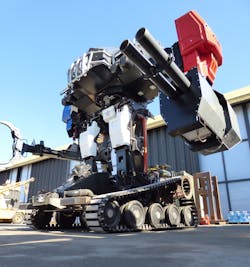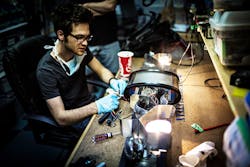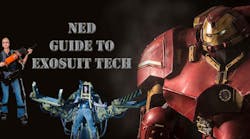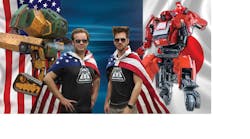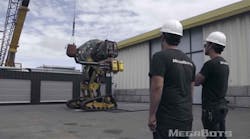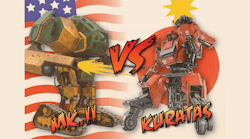As far as secret lairs of madcap scientists go, MegaBots’ Fortress One in Hayward, Calif., isn’t too shabby. Wedged between some nondescript industrial business and a lot that appears to be a cemetery for semis, this ivy-covered warehouse is surrounded by perimeter walls tall enough to hide the seldom-seen 16-ft, 12-ton war machine on the other side. As an added layer of security, there’s even a Ring video doorbell.
These guys are good.
Standing outside the place, I could only imagine what crazy antics and experiments were happening within. After all, 31-year-old co-founders Gui Cavalcanti and Matt Oehrlein, mechanical and electrical engineers, respectively, actually built their very own Iron Giant—modeled after the piloted mechs of mid ‘90s video games. Called the Mk. III at the time, but now dubbed Eagle Prime, it's intended to be the first of many MK3 class fighting mechs. And it’s also the most impressive action figure ever built, even fitted with an arsenal of interchangeable accessories like knives, a claw, a ginormous chainsaw, and a double-barreled cannon.
The MegaBots crew—which has expanded from the two co-founders to a full-time staff of more than a dozen over the last two years—”plays” with this $2.5 million toy by pummeling hybrid cars for sport, cutting up ovens, and generally finding new ways to create the wanton destruction previously only possible in daydreams or cartoons like G.I Joe.
This is probably how COBRA got its start.
It’s all for the sake of science, mind you. And to ensure MegaBots annihilates a 13-ft Japanese mech named Kuratas. The fight goes down this September, and will be posted later on YouTube.
The match has been promised and hyped since the summer of 2015, but it’s definitely worth the wait. For geeks, this isn’t merely our McGregor vs. Mayweather; it’s Optimus Prime vs. Voltron. It’s a first-of-its-kind event and has the support of huge American companies such as Autodesk and Parker Hannifin, along with several other niche manufacturers and robotics experts that keep manufacturing moving. And it has the support of nearly 8,000 Kickstarter backers who contributed more than $500,000.
Best case, this fight will spawn an entire new international sports league. Worst case, it’s still real giant robots punching each other for our amusement.
And one of them is on the other side of this gate! Maybe they’ll let me drive it!
This is mid-July, mere weeks away from MegaBots scheduled fight with Suidobashi Heavy Industries, which makes Kuratas. Just two months ago, the MegaBots team revealed its fully-functional MK3 bot at Maker Faire in San Mateo, using a pair of Toyota Prius, or Prii, as punching bags to demo the hydraulically charged power. Even at 25% strength (for public safety), the slight electric Japanese imports crumpled into submission with a few well-placed jabs.
Toyota Prius before meeting a MegaBot...
...and after.
Those totaled hybrids, by the way, lie lifeless and splattered by paintballs a few feet away from the door, serving as a savage warning to any other Japanese machine that dare face MegaBots.
Finally, Cavalcanti opens the door to the covert confines, revealing something I never expected—an ordinary-looking fabrication shop.
Oh, look. A filing cabinet. And here’s a bag of disposable towels. Safety headphones. Welding masks hanging neatly on the wall. Is this some kind of sick joke?
To make matters worse, Cavalcanti isn’t some half cyborg villain, but a thoughtful, friendly, and extremely knowledgeable tour guide wearing glasses and a charcoal MegaBots t-shirt.
He even acknowledges how low tech this supposed advanced giant fighting robot headquarters is as we pass by a Lincoln-Electric Precision Aspect 375 TIG Welder and a Kent CNC machine, the type of totally normal new equipment we write about all the time.
“We look like we’re welding a wheel loader together,” the MegaBots CEO says. “The difference here is this is a prototyping shop, whereas Caterpillar would have giant jigs for making 10,000 wheel loaders. This is more of a one off.”
So they are definitely not building a giant mech army to take over Silicon Valley. Dammit.
Cavalcanti takes us upstairs, leading us by a typical office jammed with several workstations to the left, a fairly basic setup save for the impressive robot noir art hanging on the walls. A kitchen and conference room are on the other side of the catwalk. We head to the totally corporate conference room, replete with a huge monitor, board room table and chairs.
As Oehrlein—also just a regular guy with slightly mussed hair, glasses and a t-shirt—takes over, I wonder if this is all some crazy ruse. Building a giant fighting robot can’t be this mundane.
So I ask what’s going on today, expecting they are about to practice some robo jiu jitsu takedowns, or test some sort of EMP punch.
“It’s a lot of logistical stuff,” Oehrlein, the COO, says plainly. “These are big robots; they’re difficult to move around. On the corporate side, it’s a lot of creative planning, getting the right partners involved.”
There is a trick here, and it’s been hiding in plain sight.
This MegaBots team, portrayed on YouTube as eccentric Millennial engineers (millengineers?) who take wicked delight using science to smash nice things, have a bigger secret here than a giant robot, (which I still haven’t seen yet). They are in fact serious, practical entrepreneurs.
These rogue, irreverent makers turned out to be “Transformers: Grownups in Disguise.”
The matters the MegaBots team cares about—from developing a supply chain to meeting deadlines to safety—are all things any project manager or high-level executive worries about in manufacturing. And they’ve brought together the best of the best to complete this ultimate warrior in the same way any successful manufacturer we have covered would.
The colossal ambitions to make a science-fiction mech real makes the story more compelling than most, but Cavalcanti and Oehrlein are dead-set on the same goals your company has: making something people want better than anyone else.
Before the ravenous crowds can experience this metal-on-metal violence live, as with Battlebots, which are Micro Machines by comparison, both sides have taken the safe route.
"The duel will be filmed in a private location rather than a ticketed live event because of safety concerns for the audience, and the unpredictability of the technology being used," MegaBots and Suidobashi reported in a joint statement.
That doesn't mean everyone will be out of harm's way.
Fight Science
Like a cross between Harry Houdini and Chuck Yeager, Cavalcanti and Oehrlein are putting their lives on the line to test something that is equally entertaining and groundbreaking.
“We’re doing something completely new,” Oehrlein says before a long, thoughtful pause. “There is an element of danger.”
It’s easy to forget in all the overwhelming awesomeness of seeing a clash between two piloted mechs as tall as a Tyrannosaurus Rex and twice its weight will require living, breathing humans inside. Kuratas is expected to have one pilot, while the Mk. III will have Cavalcanti at the helm and Oehrlein on weapons.
For that reason alone, the somber approach at this stage in development is understandable.
Oehrlein assures that every possible precaution has been considered, including wearing five-point harnesses, neck braces and flame retardant coveralls.
MegaBots has meticulously chronicled its prototyping process, especially the safety parts because that usually involves smashing things, such as their previous giant robot Mk. II with a wrecking ball. A sensor-laden crash test dummy sat in place of the pilots, collecting vital impact data.
The cockpit design was based on a monster truck roll cage. Oehrlein reasons that those drivers endure trucks landing upside down from 35-ft drops and walk away after.
“And in NASCAR, they slam into walls at 200 mph,” he adds, as this is probably an argument he made to his family and friends several times. “The speeds and heights we’re talking about are nowhere close to that.”
So now, the biggest danger now might be producing boring content.
“Ultimately the goal is to create an international sports league,” Oehrlein states. “The worst thing that could happen to us is we both build robots that are as effective as possible. If we wanted the most effective combat robot, we would just bring a bulldozer. It’s heavy, it’s low, you would just ram the other robot and the fight would be over.”
That’s not the must-see TV MegaBots has in mind.
“What people really want is epic giant robot combat and destruction,” Oehrlein says. “It’s got to be authentic at the same time. There’s got to be a balance.”
The Mk. III is certainly a balanced fighter, with a low center of gravity. Geoff Howe, of Howe and Howe Technologies in Maine, designed the treaded mobile base with the same ruggedness and agility as a U.S. military vehicle, or a futuristic Road Warrior.
“All of our designs have a twist of Mad Max to them, because that’s what we grew up with,” Howe says.
Although Oehrlein wants a competitive fight, Howe may have made the 430-hp Corvette (LS3) motor-powered base a bit too well.
“If the Mk. III wanted to, it could just bulldoze right through that machine and Kuratas can’t do anything about it,” Howe says. “The machine is not going to have the purchase and the coefficient friction on the ground to be able to stop that. It’s like a sumo wrestler getting up against a 135-lb. featherweight.”
This is all assuming Kogoro Kuratas—the Anime-inspired maker of Japan’s giant mech—and his army of engineers haven’t added anything new. Considering the dozens of new iterations of Power Rangers and Mobile Suit: Gundam, not to mention the business religion of kaizen, or continuous improvement, it’s fair to say Kuratas will have its own surprises in store.
Please be a laser sword. Please be a laser sword. Please be a laser sword.
One worry MegaBots’ fans have expressed online is the MK3's Achilles’ shoulder blades, where its long, vulnerable hydraulic hoses stick out. Those are necessary to provide fluid to each arm’s actuator and right now must be loose to allow flexibility. These Parker Hannifin components, which Cavalcanti calls “the fastest valves in the world,” should quickly counter the smaller, sleeker Japanese fighter’s front attacks.
Rupturing one could incapacitate the bruiser, but these are just regions they will have to protect in the fight.
Howe says the mech's zero turn ability should keep Kuratas from flanking in time to attack these weak spots, and the torso spins so fast it could be a hurl-worthy carnival ride when it retires from fighting.
If this exhibition does morph into something more, that could include a number of WWE-style theatrics, such as entrance music, or t-shirts being shot out of Eagle Prime's air cannon.
It certainly has Howe and several other MegaBots’ partners we contacted excited. (Check our online coverage for a detailed conversation with each.)
“This is going to be the future Super Bowl,” Howe says. “I think you’re going to see this spread and grow and be a huge international hit in the next 10 to 15 years, because it’s exciting and it’s the real deal, not scripted.”
For true aficionados of wanton destruction, that’s an excellent hook. And smart business model.
More schools across the country have robotics competitions, and as with high school football, some could get college scholarships and then go pro in this proposed league. The rest just have a good time, learn one of the most marketable skills for the next several decades, and get a great job.
And the start of that could kick off with this fight, what could be looked at in a century as the moonshot event for robotics.
“I want people to feel like they live in the future,” Oehrlein says. “I want people to say ‘Holy shit, I didn’t think this would happen in my lifetime.’”
The Big Reveal
As a kid, I couldn’t imagine a future without giant fighting robots.
Standing in the shadow of this absolutely real—and quite stunning—crouching man-made beast, I can officially announce it’s the future. Its luminous metal frame glows under the cloudless mid-afternoon sky, a red, white, and blue angel sent from heaven to blow stuff up.
I would cry tears of joy, but that’s not the kind of thing you do in front of such a finely crafted machine of death. It just isn’t proper.
What MegaBots has created out of commonly available tools and trades stirs the same sort of pride I feel standing for the national anthem. As I looked on, waiting for the giant beast to rise to its full 16-ft. stature, the communication between the engineers in the cockpit and Oehrlein down below seemed to be more tense than usual pre-movement safety checks. They kept running systems checks, but the beast still lay dormant.
I shuffled through the enclosed work yard full of shipping containers and parts while they work.
Tucked in a corner, the Mk. II rests in repose, its battered faceplate strewn on the concrete. In 2015, it ignited imaginations. Now it seems antiquated and very DIY, with some parts covered in painted Styrofoam, and a missile array made from PVC.
Despite the imposing, professional look of the new mech in town, the Mk. II means more to its makers than just an early prototype. It’s a monument to MegaBots’ rogue origin at makerspaces—urban DIY havens for those with an insatiable industrious spirit but no access to welding and machining equipment to bring their ideas to life. In a previous life, Oehrlein ran i3Detroit and Cavalcanti the Artisan’s Asylum in the Boston area.
“It’s a gym membership for your brain,” Oehrlein explained earlier with even more energy than usual. “Instead of a weight lifting equipment, you use a CNC machine or a laser cutter, a welder or 3D printer.”
It is the lowest possible barrier to entry to get their hands on manufacturing equipment,” he continues. “Pay for your membership, take a two-hour class, and you are up and running.”
Cavalcanti first met former Autodesk CEO Carl Bass there by chance, a relationship that grew in MegaBots’ first and most important partnership. After it was constructed, Autodesk transported the Mk. I—just a cockpit and a cannon—from Boston to Las Vegas to show off at a company event, a trip Mike Geyer, lead evangelist for Autodesk, recalls.
Geyer says the MegaBots co-founders tenacity in the face of logistical changes and broken parts secured the design software giant’s patronage, which included guiding MegaBots design from one-off prototype to a repeatable design others could use to build their own fighting robot using makerspaces to construct this future ultimate fight club.
Whether that happens or not, this robot built at Fortress One proves the potential of a makerspace built simply by will power and the never-fading adolescent dreams of two brilliant builders who know their way around a workshop and a sales pitch.
Geyer believes this makerspace movement is the start of something huge.
“More and more people are able to now participate in bringing the crazy ideas to reality, and many of those are going to turn out to be terribly disruptive to our traditional manufacturers,” he says.
This new world will emphasize doing while learning, getting your hands dirty as opposed to just scribbling in a notebook.
“The days of the professor at the podium are over,” says Geyer.
As MegaBots has strived to become more like a big company and expand, it seems industry’s economic giants are following in their footsteps (and tanks treads), focusing on lean, super-fast fabrication and doing whatever it takes to make their goals a reality.
Of course, there will be days like today, full of boring clerical work, intrusive journalists, and out-of-whack parts. As part of manufacturing’s ruling class now, they’ll have to get used to it.
About that final headache, the team quickly found a loose connection and the next day the Mk. III rose to the occasion for our cover shoot, looking quite heroic, like its proud parents.
“The reward piece for us is inspiring the next generation of scientists and engineers to do really cool stuff,” Oehrlein concludes.
Damn. These guys are really good.
On the way out, I buy a MegaBots t-shirt for my step son, who will lead his high school robotics team this year. It wasn’t shot from a robot cannon, but the story behind it is just as awesome.
Epilogue
After my visit, MegaBots announced their combat mech's new name: Eagle Prime. MK3 is now referred to as the class of robot, like the military refers to its jets, tanks, or ships.
They also released the video below to demonstrate the truly destructive power and graceful agility of this amazing athlete of the future and answers the question why the Mk. II had its face torn off:
